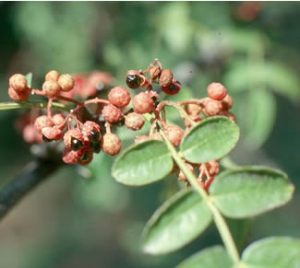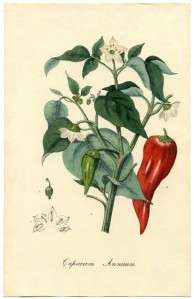
Barra, A. (1999). Prickly Ash Zanthoxylum spp.. Retrieved from: http://www.anniesremedy.com/herb_detail403.php
Botanical Name: Zanthoxylum clava-herculus /Z.americana
Common name: Prickley Ash
Family: Rutaceae (Hoffmann, 2003, p. 596)
Parts used: Bark, Berry (Hoffmann, 2003, p. 596)
Constituents: Alkaloids; coumarins; resin; tannins; and volatile oil (Hoffmann, 2003, p. 596)
Actions
- Circulatory Stimulant (Hoffmann, 2003, p. 596; Bone & Mills, 2013, p. 233)
- Tonic (Hoffmann, 2003, p. 596)
- Alterative (Hoffmann, 2003, p. 596)
- Carminative (Hoffmann, 2003, p. 596)
- Diaphoretic (Hoffmann, 2003, p. 596; Bone, 2003, p. 379)
- Antirheumatic (Hoffmann, 2003, p. 596)
- Hepatic (Hoffmann, 2003, p. 596)
- Sialogogue (Bone, 2003, p. 379; Bone & Mills, 2013, p. 104)
Indications
- Rheumatism (Hoffmann, 2003, p. 596; Bone, 2003, p. 379)
- Chronic skin disorders (Hoffmann, 2003, p. 596)
- Poor circulation (Hoffmann, 2003, p. 596; Bone, 2003, p. 379)
- Leg cramps (Hoffmann, 2003, p. 596)
- Varicose veins (Hoffmann, 2003, p. 596; Bone, 2003, p. 379)
- Varicose ulcers (Hoffmann, 2003, p. 596)
- Gastric distension (Hoffmann, 2003, p. 596)
- Loss of sensitivity in injured nerves (Hoffmann, 2003, p. 596)
- Haemorrhoids (Bone, 2003, p. 379)
- Raynaud’s Syndrome (Bone, 2003, p. 379)
- Hypotension (Bone & Mills, 2013, p. 233)
Dosage & Preparation:
- Tincture (1:5 in 60%): 2-4mL/tds
- Infusion: 102tsp/1 cup water/tds
Cautions
- Causes a tingling sensation in oral cavity when taken in liquid form, which may give patients a chocking or panicked reaction (Bone & Mills, 2013, p. 104)
Contraindications
- Contraindicated in hypertension (Bone & Mills, 2013, p. 233)
- Individuals on anticoagulant therapy (Hoffmann, 2003, p. 596)
